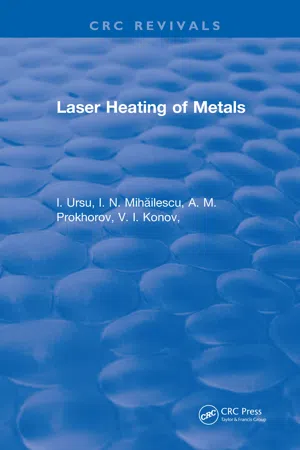
- 259 pages
- English
- ePUB (mobile friendly)
- Available on iOS & Android
Laser Heating of Metals
About This Book
In order to ensure efficient use of lasers, and for any large-scale implementation, a thorough knowledge of the fundamental laws governing the interaction of radiation with matter is required. Laser Heating of Metals provides a systematic and comprehensive presentation of the fundamental principles underlying the physical and chemical mechanisms governing the interaction of laser radiation with solid targets, and in particular metals in gaseous environments, for a wide range of beam parameters. The authors have been active in the field of interactions between lasers and materials for many years, and this book summarises the results of their work, in particular concerning the action of CO2 lasers on metals. These results are then discussed at some length. Laser Heating of Materials will be of interest to scientists at all levels with an interest in the interaction of radiation with condensed matter, and in particular to those involved in laser cutting and welding etc, and metal-working.
Frequently asked questions
Chapter 1
Optical Properties of Metals
Table of contents
- Cover
- Half Title
- Title Page
- Copyright Page
- Table of Contents
- Series Editors’ Preface
- Preface
- List of Symbols and Abbreviations
- 1 Optical Properties of Metals
- 2 Basic Regimes of the Heating of Metal Targets by Laser Irradiation
- 3 Thermoelastic Deformation of Metal Surfaces
- 4 Light Stability of Metal Mirrors Exposed to Pulsed Irradiation in a Vacuum
- 5 Surface Periodic Structures
- 6 Laser-induced Oxidation and Burning of Metals
- 7 Optical Effects and Diagnosis of Thermochemical Interaction Processes
- 8 The Choice of Optical Irradiation Conditions
- References
- Index